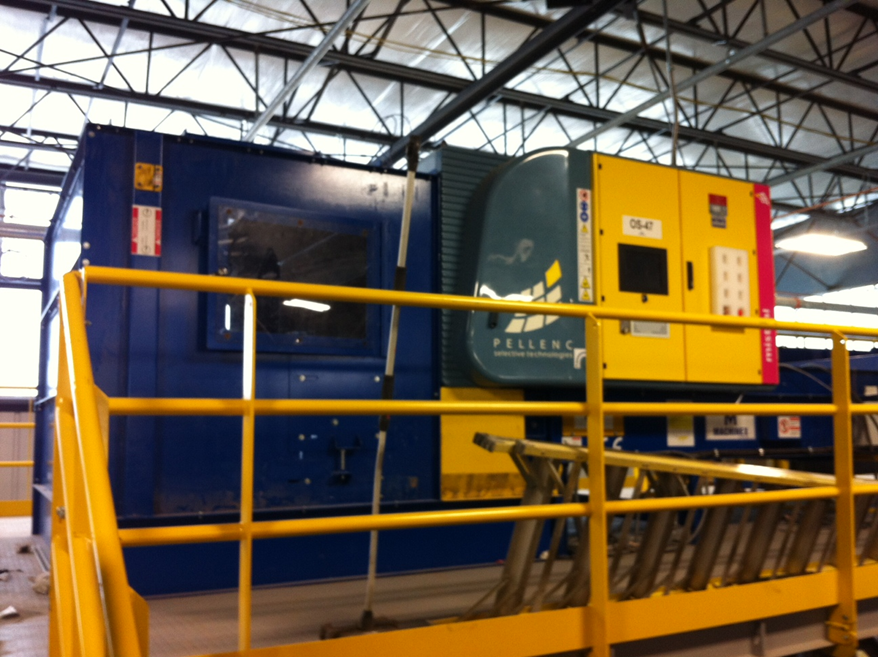Recently, members of our St. Louis office’s Green Team visited Republic Services’ Recycling Center in Hazelwood, Missouri. Our team wanted to dive deeper into the world of single stream recycling and see it firsthand.
You’re surprised by a large mound of trash when you first get to the recycling center. How did this trash end up here instead of the landfill? People want to do the right thing, but are sometimes guilty of “wishcycling.” Not everything that consumers think are recyclable.
Our team got to see how this trash gets sifted out and how recyclables are separated by commodity. The Republic Services in Hazelwood recycles over 300 tons of material per day with the help of heavy duty equipment and their personnel.
Recycling Process
- Dump trucks bring the mixed recyclables to the facility and place them on the tipping floor. The material is grabbed from the floor and placed in a drum feeder which distributes it on a conveyor belt.
- Items are sent to a pre-sort station. Employees extract items such as plastic bags or hangers, as well us anything that can jam up the line. Plastic bags are especially dangerous because they can clog machines. Someone would need to be lowered into the machine and cut it away manually.
- Items are then sent through various screens and sorters. Cardboard is lifted out as glass falls naturally and is crushed. Paper is screened and sorted. Throughout, QA workers ensure contaminated materials are pulled out.
- Plastic, aluminum, and steel fall through various other screens to go through their sorting process. Steel is pulled out through a magnet. An eddy current is used to pull out aluminum.
- Plastic is the sorted using optical sorters. These use light to identify what the plastic is made of. PET plastic is sorted with Optical #1. PET plastic is most commonly found in water bottles. Optical #2 pulls out HDPE plastics such as milk jugs and laundry detergent bottles. Aseptic packaging, cartons, and other plastic are gathered by Optical #3.
- After being sorted, the recyclables go into bunkers. They are then turned into bales and sold.
- Leftover materials are sent to the landfill.
Want to find out more about how the machines work? Find out here.
One of the main themes of the tour was how important it is to know what to recycle and to how to do it correctly. St. Louis City and County along with Republic Services have been working to educate the community on recycling.
Recycling 101
The most important thing we heard was to keep your recyclables loose – never bag them. Plastic bags can get stuck in the machinery causing damage to equipment. Equally as important, only place the following items in your recycling container:
- Flattened cardboard: Breaking down cardboard makes it easier to process and gives you more room.
- Paper: Newspapers, magazine, office paper, and common mail can all be recycled. Make sure to remove plastic windows or anything that would contaminate it. Shredded paper should not be included in your single stream recycling bin.
- Metal Cans: Clean out any leftovers from cans. Make sure they’re dry so they don’t contaminate your other recyclables.
- Plastic Bottles & Jugs: Keep your lids on. Make sure you don’t include flexible plastics like grocery bags, bubble wrap, or styrofoam which need special handling.
- Cartons: Remember to make sure they’re dry.
- Glass: Wash out and dry. Don’t throw it in with liquid.
Did you know?
- A recycled aluminum can can be recycled and back on the shelf as new in as little as 60 days.
- If we recycled all of our newspaper, we could save about 250,000,000 trees a year!
- Recycling one ton of plastic saves the petroleum equivalent of 1,500 gallons of gasoline.
- Recycling creates 8 times as many jobs as incineration and landfills.
- It’s cheaper to make material from recycled products than it is to make from scratch.
- Americans make more than 200 million tons of garbage each year, enough to fill Busch Stadium from top to bottom twice a day.
Recycling isn’t as hard as it sounds. There are tons of resources out there to help educate you on the do’s and don’ts. Check out recyclingsimplified.com to learn more and don’t forget to check your municipality to see what recyclables they accept.
What is the Green Team?
Members of our St. Louis office are always looking for new ways to get involved with community. We decided to form an environmentally friendly coalition, “The Green Team”. Our goals include making Perficient a more eco-friendly place to work, expand our marketing reach specifically towards recent college grads, and track the financial impact that can be gained from making smarter choices by focusing on sustainability. Among others, education and action were the prime directives. One of our first objectives however was to participate in the 2019 St. Louis Green Business Challenge, run by the Missouri Botanical Garden and other leaders in our region. The Challenge has helped encourage various sustainable practices at our office that can be done on a daily basis.
One of the highlights of our journey towards a greener world was our visit to the Republic Services Recycling Center in Hazelwood, Missouri. Republic Services is one St. Louis community’s top recycling facilities and is the 10th largest single stream Material Recovery Facility in the nation. Through a sustained trajectory, the St. Louis Perficient office will be a flagship towards a brighter and cleaner tomorrow.
Learn more from our Green Team!





